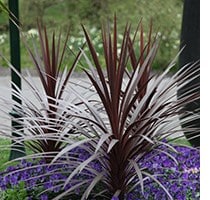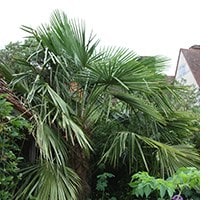Cordyline

Cordylines are tufted evergreen shrubs that originate from Southeast Asia and the Pacific rim, where they mature to form awkwardly shaped stubby trees with tufts of spiky leaves that resemble huge pineapple tops at the end of each branch. In this country they are generally grown as feature focal points where their evergreen leaves provide interest throughout the year. Cordylines make excellent container plants, but can also be used as points of focus in bedding schemes or to add foliage relief in a mixed border.
 Although grown for their foliage, Cordylines do flower. In mid-summer an enormous and slightly preposterous spray of small white flowers is produced followed by little round red or purple berries. The leaves of a Cordyline grow in a rosette circling the central stem. This distinguishes it from the similar looking Phormiums (New Zealand flax), which produces its leaves in a fan shaped arrangement. There are seven varieties of Cordyline but only C. australis is hardy enough to be grown outdoors in milder areas in this country. As well as the green-leaved species, there are lots of interesting varieties from the cream-striped 'Torbay Dazzler', the purplish-red leaved ‘Red Star’.
Although grown for their foliage, Cordylines do flower. In mid-summer an enormous and slightly preposterous spray of small white flowers is produced followed by little round red or purple berries. The leaves of a Cordyline grow in a rosette circling the central stem. This distinguishes it from the similar looking Phormiums (New Zealand flax), which produces its leaves in a fan shaped arrangement. There are seven varieties of Cordyline but only C. australis is hardy enough to be grown outdoors in milder areas in this country. As well as the green-leaved species, there are lots of interesting varieties from the cream-striped 'Torbay Dazzler', the purplish-red leaved ‘Red Star’.
Variety guide
 Cordylines are architectural and evergreen, looking good and providing interest all the year. In borders they combine well with other exotica, such as Musa (bananas) and Trachycarpus fortunei (chusan palm), which are now quite widely available, but they look equally at home in more conventional and hardy ornamental borders.
Cordylines are architectural and evergreen, looking good and providing interest all the year. In borders they combine well with other exotica, such as Musa (bananas) and Trachycarpus fortunei (chusan palm), which are now quite widely available, but they look equally at home in more conventional and hardy ornamental borders.
In a border
 Cordylines make a strong vertical shape in a border and mix well with some of the softer, gentle grasses like Calamagrostis x acutiflora 'Overdam' (feather reed grass) and Stipa tenuissima (syn. Stipa tenuifolia), which offset their sharp, hard lines. They also look good adjacent to the grassy foliage of Kniphofias (red-hot pokers), Veronicastrum (culver's root) and Verbascum (mullein), which are flamboyant enough to hold their own in the border.
Having quite dramatic foliage, Cordylines mix well with other strong shapes. Their thin, simple blade leaves can be brought into relief when planted alongside wide glossy foliage of Fatsia japonica (Japanese aralia) or the lush fingered leaves of Paeonia (peonies), the bold leaves of Hosta (plantain lily) and the totally monstrous Gunnera manicata (Chile rhubarb).
When choosing flowering neighbours for a Cordyline opt for fiery colours like reds, yellows and oranges. Canna lilies with their startling flowers and decorative leaves are perfect, or try a hot mixture using dahlias, Hemerocallis (day lily) and Crocosmia (montbretia) for an dramatic, fiery display.
Cordylines make a strong vertical shape in a border and mix well with some of the softer, gentle grasses like Calamagrostis x acutiflora 'Overdam' (feather reed grass) and Stipa tenuissima (syn. Stipa tenuifolia), which offset their sharp, hard lines. They also look good adjacent to the grassy foliage of Kniphofias (red-hot pokers), Veronicastrum (culver's root) and Verbascum (mullein), which are flamboyant enough to hold their own in the border.
Having quite dramatic foliage, Cordylines mix well with other strong shapes. Their thin, simple blade leaves can be brought into relief when planted alongside wide glossy foliage of Fatsia japonica (Japanese aralia) or the lush fingered leaves of Paeonia (peonies), the bold leaves of Hosta (plantain lily) and the totally monstrous Gunnera manicata (Chile rhubarb).
When choosing flowering neighbours for a Cordyline opt for fiery colours like reds, yellows and oranges. Canna lilies with their startling flowers and decorative leaves are perfect, or try a hot mixture using dahlias, Hemerocallis (day lily) and Crocosmia (montbretia) for an dramatic, fiery display.
Cordylines, although Mediterranean in style, do sit very well with more traditional garden elements, such as topiary. At first this might seem an odd and discordant combination – the classic style of parterres and clipped hedging with palm-like plants? However, if the lower leaves of the Cordylines are cleared away so it is left with a straight bare trunk and a neat head of sharp pointy of leaves, this works as a very striking and effective alternative to the more usual standards you find in formal gardens.
In containers
 Cordylines are ideal container plants. They are strongly architectural and make a simple, bold statement. There is no need to fill the containers with hundreds of smaller plants, which are quite fiddly and require lots of attention. Instead, just keep it simple with a Cordyline in a pot topped with pebbles, cobbles or gravel for an elegant centrepiece. If you do want to fill the pot up, try the tumbling Sedum 'Ruby Glow' (stonecrop) under the red leaved 'Atropurpurea' for a drought-tolerant combination. Or use billowing bedding in contrasting or complementary colour.
Cordylines are ideal container plants. They are strongly architectural and make a simple, bold statement. There is no need to fill the containers with hundreds of smaller plants, which are quite fiddly and require lots of attention. Instead, just keep it simple with a Cordyline in a pot topped with pebbles, cobbles or gravel for an elegant centrepiece. If you do want to fill the pot up, try the tumbling Sedum 'Ruby Glow' (stonecrop) under the red leaved 'Atropurpurea' for a drought-tolerant combination. Or use billowing bedding in contrasting or complementary colour.
The biggest problem with containers is that they tend to dry out really quickly. Cordylines are very drought tolerant and can withstand the rigors of this fairly harsh environment. The best compost to use is the loam-based John Innes No2 which is still quite free draining, but does tend to hold water much better than many of the peat-based multipurpose composts. You can also add water retaining granules - these look like crystals but swell up to form a jelly-like substance when full of water – which can also help.
Growing guide
Cordylines are dramatic and eye-catching and yet solidly dependable garden plants which are easy to maintain and rarely suffer from pests and diseases. However, they do need a well-drained soil that is in sun or part shade. They are surprisingly hungry plants, too, so the soil needs to be quite fertile for them to really flourish. It is worth digging in some well-rotted farmyard manure before planting. This will add lots of nutrients to the soil and help to retain moisture without making the soil water-logged.
As the Cordyline grows the lower leaves start to droop down and eventually turn yellow and then brown. These can be either left as they are, or cut, so you get a clear trunk with a shock of leaves on the top.
Although they have a tropical air, Cordylines can cope with temperatures down to –5oC (20oF), so are hardy in most areas. In very cold regions it is worth tying the leaves up to the stem so that the crown is protected from the worst of the winter weather. Use a forgiving material, such as fleece, raffia or a pair of old tights, to tie that plants so the leaves aren't bruised or cut.
Propagation
Cordylines grow surprisingly well from seed and this is the best way to propagate C. australis . Seeds should be sown in the spring and are best started off in a propagator and then moved into a warm, sunny spot once the weather really warms up. In their first winter they are best moved into a greenhouse or conservatory for some protection while they are still young. Cordylines also can be propagated from hardwood stem cuttings, although it will take between three and five years to get a decent-sized plant. It sounds brutal, but take sections out from healthy stems, about 10cm long. Make sure you take the sliced cuttings with a sharp knife. Lay them wound side down in free-draining compost, water and keep in bright shade.
Pests and disease
Cordylines that are grown outdoors are generally trouble free, but can occasionally rot at the base of their stems if over watered or if planted in soil that remains wet. Once this happens, the cordyline topples over and there is nothing that can be done to revive them.
Crocus tip
Make sure that the foliage of the Cordyline is thoroughly dry before you wrap it up for the winter, so wait until there has been a dry spell with a drying wind. If Cordylines are wrapped wet they are liable to rot.










